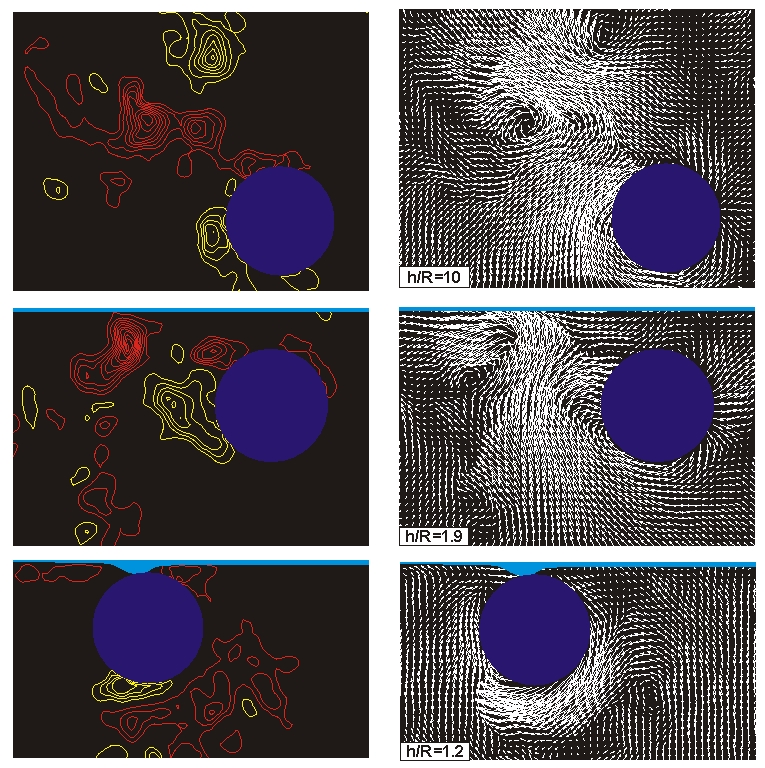You are here
Home ›Horizontal Oscillations of a Cylinder beneath a Free-Surface
Horizontal oscillations of a cylinder beneath a free-surface. Horizontal oscillations of a cylinder simulate long-wave motion past a stationary cylinder. When a cylinder is well-submerged beneath the free-surface, corresponding to h/R = 10, represented by the top row of images, a vorticity layer of positive vorticity is shed from the upper surface. It exhibits a train of smaller-scale concentrations, which form a counterrotating system of vorticity with the negative concentration of vorticity shed from the previous cycle. Simultaneously, a pronounced layer of negative vorticity forms along the lower left surface of the cylinder. The corresponding velocity field suggests a large-scale counterrotating pair. When the cylinder is moved closer to the free-surface, corresponding to h/R = 1.9, the mode of vortex formation changes completely. An alternating vortex system tends to form from the cylinder; it is accompanied by a jet-like flow initially directed upward towards the free-surface, then deflected to the left at the surface. Finally, when the cylinder is very close to the free-surface at h/R = 1.2, the gap between the cylinder and the free-surface has zero width due to a local depression of the free-surface. A large-scale concentration of positive vorticity, shed during the previous cycle, moves clockwise along the lower surface of the cylinder. In the corresponding velocity plot, it is evident that a jet-like flow around the lower surface of the cylinder is associated with the large-scale concentration of vorticity. All of the foregoing classes of vortex formation contribute to pronounced, but distinctly different, spikes of the transverse force signature. h = distance from upper surface of cylinder to free-surface; R = cylinder radius; Keulegan-Carpenter number KC = 2 πA/D = 10.
The patterns of vortex formation from a cylinder oscillating in a horizontal plane, located at various depths of submergence beneath a free-surface, are characterized using high-image-density particle image velocimetry (PIV). Instantaneous representations of the velocity field, streamline topology and vorticity patterns are referenced to the instantaneous velocity of the cylinder. In turn, these features are related to the magnitude and phase of the instantaneous transverse force, which can exhibit highly nonlinear, spike-like fluctuations. When a finite gap is maintained between the free-surface and the cylinder, the patterns of vorticity concentrations are altered in such a fashion that both the peak magnitude and the degree of amplitude modulation of the negative transverse force spikes are attenuated, but shifted little in phase, relative to the case of the fully-submerged cylinder. On the other hand, when the cylinder is sufficiently close to the free-surface such that the gap region is eliminated, the patterns of vorticity concentrations are fundamentally different and the negative transverse force spikes are remarkably more pronounced and consistent than for deeper submergence.

